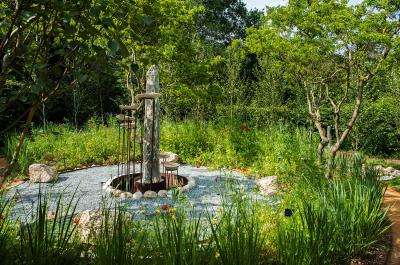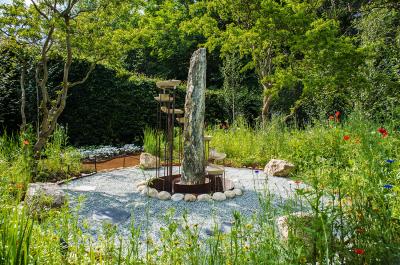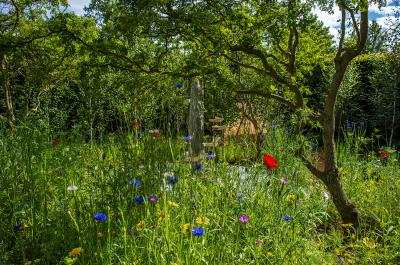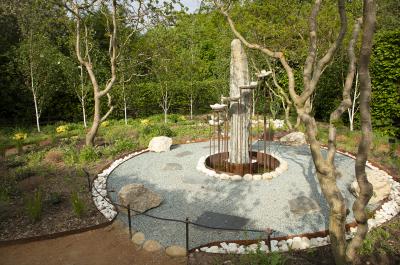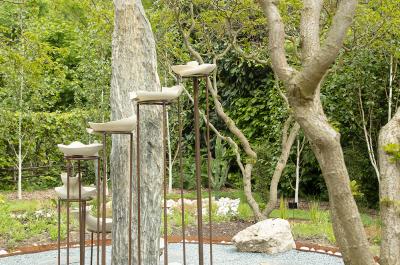04bis. Le jardin Eaurmus
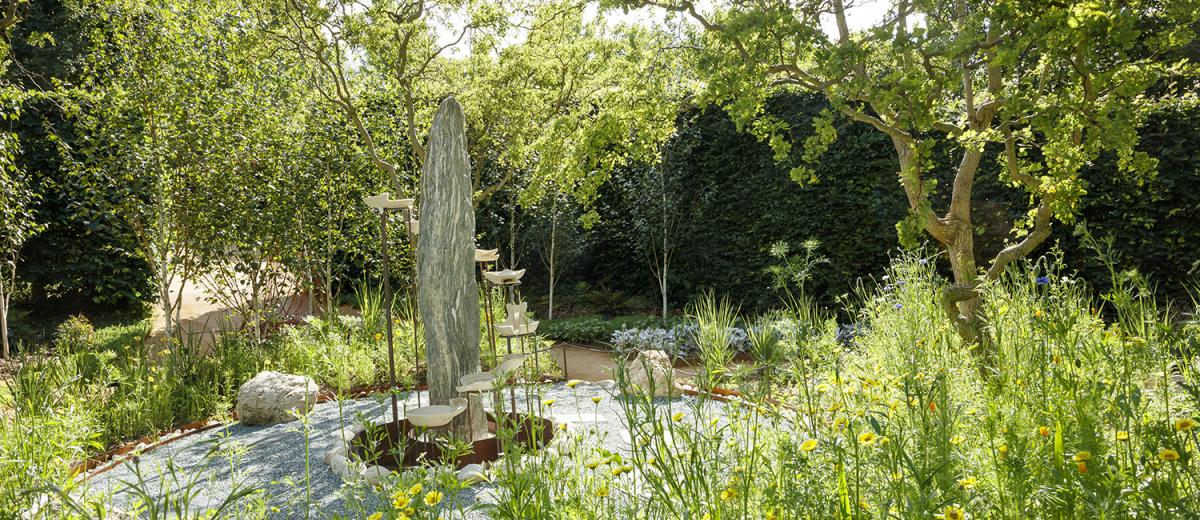
Like an alchemist seeking to turn lead into gold with the Philosopher’s Stone, the “Eaurmus” ideal garden is the physical expression of a subtle transformation making use of cosmo-telluric and human energies. Alchemy is connected with the idea of quintessence, a fifth element that includes mind and thought, and which was supposed to play a key role in production of chemical reactions. Here, a substance as innovative as it is archaic – Ormus – maximises the vital energy located in the ground. It exists everywhere in nature: in our bodies, the air, the soil, and in various plants and fruits including aloe vera and red grapes. It belongs to a special class of powerful rare minerals, the platinum group, transformed in their monoatomic state through vortex motion and control of acidity. These transformed minerals are beneficial to all cellular life. They act as superchargers, enabling clearer cell-to-cell communication with no energy loss. Ormus is used in South Africa to rejuvenate the land. Mixed with water, it rapidly reconstitutes the soil microbiome. It enables gardeners and farmers to do without synthetic fertilisers and harmful products. It pays attention to the bond established with nature, a bond of love rather than domination.
DESIGNERS
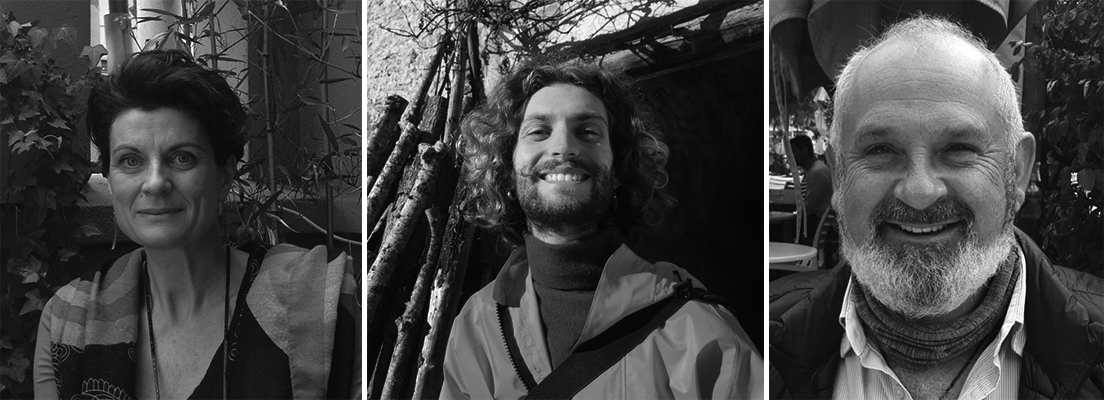
Adrien Folliot, a young engineer and engineer who recently completed studies undertaken at two schools in parallel in his native city of Paris, is now fulfilling his potential by carrying out architectural research and development as a member of the Comet Lab collective. During his student days, his initial focuses were on the theme of the body in its dialogue with architecture, in particular through dance, of which he is a passionate practitioner, and then on the theme of thresholds. As a result of his many travels across the world, as an explorer and humanitarian volunteer, he has developed an interest in the theme of water as a key element in the management of natural risks. In this regard, he obtained a Golden Award at an international architecture competition. Alongside his evolution in ever-increasing symbiosis with living beings and their principles, essence, recycling, sharing, interdependence and resilience, he has developed great sensitivity towards the sacred, largely due to his ties with Italy, a country whose baroque churches have been a significant inspiration for him. Hence, he now tries to implement the knowledge he has acquired with regard to spirituality, bioinspiration, geobiology, quantum physics and travel in the architecture he designs. He takes an interdisciplinary approach, for example, in the work he carries out with his friend the ceramist and potter Igor Borensztein, a geobiologist colleague Jean-Jacques Remigereau, and the well-known landscaper Florence Mercier, all of whom have taken part in the creation of the Jardin d’Eaurmus.
Cristiana Mazzoni qualified as an architect in Venice and has devoted her life to guiding younger generations, whom she has kept a close eye on, both as regards training and professional integration, through fundamental research and action research alike. Focusing on the importance of personal fulfilment and engagement, she sees projects as means of expressing the genius we all harbour within ourselves. She is a Professor at the Paris-Belleville National Higher School of Architecture, where she also directs a CNRS joint research unit, was Visiting Professor at Genoa and Hamburg, and has lectured at European and Asian universities, including in Shanghai, Nanking, Guangzhou, Dalian and Singapore. In this context, she has taken part in a great deal of research work for ministerial programmes and has published almost a hundred books and articles on architectural theory and practice. She is currently interested in the transition of architecture, urban planning and landscape to holistic, quantum forms of design. In 2008, she co-founded the CMYT Architecture Studio, and is senior expert at Comet Lab, an innovative young company specialising in R&D in architecture. Together with her team of young graduates and doctoral students, she exhibited her educational, research and professional work at the 2018 Venice Architecture Biennale, for the "Space Time Existence" programme at Palazzo Bembo. These days, she is getting the team to explore architecture’s dialogue with augmented reality, bioinspiration and geobiology.
Peter Searll is now a South African alchemist who believes that life is meant to be lived fully. He is extremely passionate about the soil, which is the basis of all life on earth, and is saddened by the way we treat it. But it wasn't always like this...After graduating from the University of Cape Town with a degree in Business Science, specialising in marketing and marketing research, he spent the first part of his career teaching marketing research, consumer behaviour and statistics. As an innovative researcher and businessman, he has won two prestigious awards in the field of marketing research. He designed and managed the largest brand tracker in Africa and the Middle East for over 10 years, but felt he had something more important to do. His late cousin, Dan Schreiber, a mystic, scientist and inspirational being, introduced him to Ormus in 2015. This was the tipping point for him, who immersed himself in the task of making a positive impact in the world through the Ormus' potential to be a holistic healer - raising the vibration of everyone it comes into contact with. As a teacher and researcher, Peter realised that regenerative agriculture is ideal for the Ormus. He has studied this emerging field with a voracious appetite, and understands that regenerating our soils is the best solution for our survival - ecologically, economically, ethically and spiritually. So in 2018, together with a group of researchers and scientists, he founded the TransfOrmus laboratory based in Cape Town, South Africa. Creating Ormus is about working with nature rather than trying to dominate it and can enable us all to re-establish the right relationship with our planet and all those who share it.
